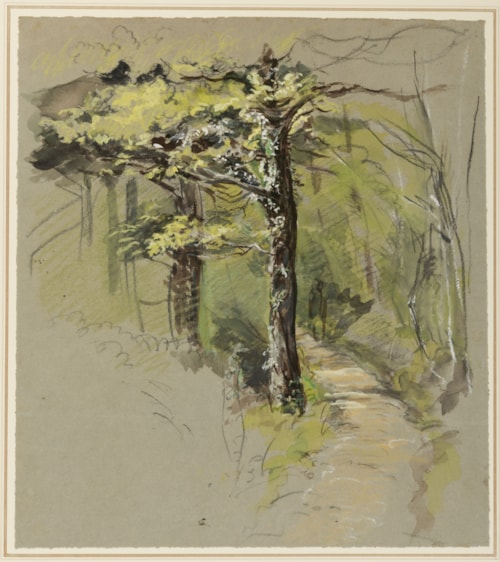
William LINNELL
London 1826 - London 1906
Biography
Born in 1826, William Linnell was the third son of the acclaimed British landscape artist John Linnell. A close friend of William Blake, John Linnell chose to name his son in honour of him. William Linnell studied at the Royal Academy Schools alongside his two brothers James Thomas and John. In 1866 William married a Frenchwoman, Isabelle Schuster, and the couple briefly resided in Paris. When they returned to England in 1868, William’s father expressed his desire to build them a home on the Linnell family estate at Redhill, near Reigate in Surrey, as had been done for his brother James. William and Isabelle Linnell had three daughters, Katharine Anne, Emilie Sarah and Isabelle, but tragically Isabelle died in giving birth to their third daughter, in 1870. Afterwards, William’s sister Mary Ann, known as Polly, cared for his three children when the artist and his children moved into their home at the Redstone estate in November 1870, shortly after the death of Isabelle. William became known for his depictions of English and Welsh landscapes and rural scenes, many of which were exhibited at the Royal Academy between 1851 and 1891. Paintings by the artist are today in museums in Birmingham, Gateshead, Liverpool, Sheffield, Wolverhampton, and elsewhere.
Both William and James Linnell were regarded by contemporaries as worthy successors to their father’s legacy. William Blake’s 19th century biographer Alexander Gilchrist noted that, ‘Both brothers were destined to become famous in the picture-loving world. The art of landscape-painting will be indebted not only to John Linnell whom two generations have delighted, and many more will delight to know, but to the Linnell family collectively. Time after time, James and William Linnell have evinced capabilities which might carry them onward to almost any point of attainment in the art. In both we recognise keen, fresh, strong feeling, vivid perception, plenteous, expressive, sometimes startling realization; qualities which they are able to develop and combine in a form equally grateful to the ruralist and to the lover of art.’
Writing a few years later, in 1872, an art critic further noted that ‘James Thomas Linnell...is entitled to share with his brother William the estimation in which their pictures are held by the amateur and collector, sometimes rivalling even those of his father...It is so rare an occurrence to find a picture by any one of the Linnell family bearing the distinctive title of the place represented, that one would naturally be led to suppose the compositions are merely imaginary; but this, as a rule, is far from the case. Surrey, and the wealds of Sussex, supply the artists with the ground-work of most of their beautiful compositions, and the localities may generally be recognized by those who are well acquainted with them.’


